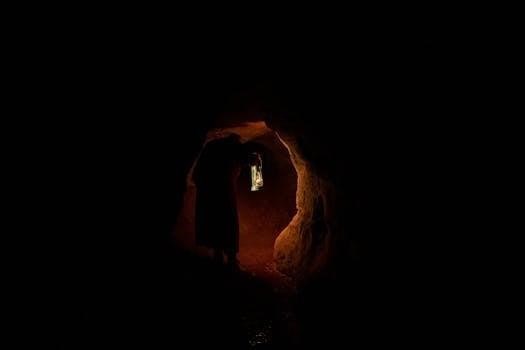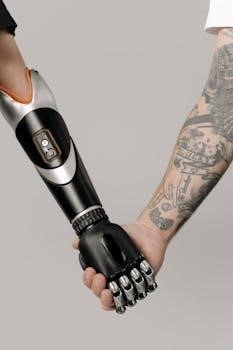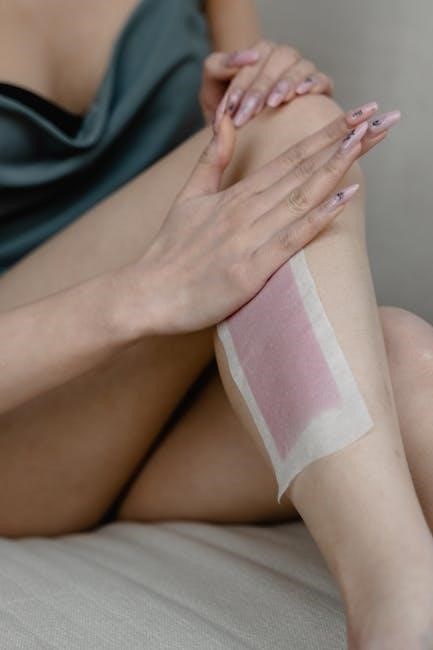Embark on your journey as a Necromancer in Guild Wars 2, a master of dark arts, controlling life force and summoning minions․ This guide will provide crucial insights into efficient leveling strategies, focusing on core mechanics and build choices․
Overview of Necromancer Class
The Necromancer in Guild Wars 2 is a versatile profession, wielding dark magic to drain life force, summon undead minions, and manipulate death․ Their core mechanic revolves around generating life force by defeating enemies or using specific abilities․ This resource fuels their powerful Death Shroud form, granting a second health bar and unique abilities for survival and offensive pressure․ Necromancers are known for their ability to both deal damage and sustain themselves, making them formidable in solo play and valuable in group content․ They excel at controlling the battlefield, weakening foes with conditions, and bolstering their presence with minions․ A core part of the Necromancer’s identity is their ability to adapt and use different weapon combinations, each offering a unique playstyle․ Mastering the interplay of life force, minions, and Death Shroud is key to effectively playing this class․

Core Leveling Strategies
Efficient leveling for a Necromancer involves focusing on minion summoning, utilizing life force, and unlocking key traits․ Prioritizing damage and survivability is crucial for a smooth solo leveling experience․
Early Game Focus⁚ Minions and Life Force
In the early stages of leveling your Necromancer, your primary focus should be on mastering the use of minions and efficiently managing your life force․ Minions, particularly Skeletal Mages, will form the backbone of your damage output in the initial levels, allowing you to focus on survivability․ As you engage in combat, pay close attention to how life force is generated, primarily through enemy deaths and certain skill activations․ This resource is vital for entering Death Shroud, which acts as a secondary health bar and provides access to potent abilities․ Learning to seamlessly transition in and out of Death Shroud early on will significantly enhance your effectiveness and survivability․ Experiment with different minion types to find what works best for your playstyle and adapt to various combat scenarios; It’s important to understand the strengths of each minion to maximize their potential․
Trait Unlocking Order⁚ Spite, Soul Reaping, Death Magic
When leveling your Necromancer, prioritize unlocking trait lines in a strategic order to maximize efficiency․ Begin with the Spite trait line, known for its direct damage enhancements, which will boost your overall DPS output significantly․ Next, focus on Soul Reaping, which provides a smoother class flow through life force generation and sustainment․ This trait line improves your ability to utilize Death Shroud more frequently, making you more resilient․ Finally, unlock Death Magic․ While some guides might suggest Curses, Death Magic offers a nice balance between utility and damage that synergizes well with the other two lines․ Unlocking traits in this specific sequence will provide a balanced approach to offense and defense, making your leveling experience smoother and more enjoyable․ This path also sets a solid foundation for future builds․

Build Focus
This section highlights key build aspects for leveling your Necromancer․ We’ll explore optimal trait line combinations, weapon choices, and skill priorities to ensure a powerful and effective experience․
Trait Line Choices⁚ Spite, Blood Magic, Soul Reaping
When leveling your Necromancer, the choice of trait lines significantly impacts your playstyle and effectiveness․ Prioritize Spite for increased damage output, making your attacks hit harder and faster, which is very effective against most enemies․ Blood Magic offers enhanced survivability, providing crucial self-healing and sustain, making you harder to kill especially when soloing content․ Soul Reaping provides a more fluid experience, improving life force generation and access to Death Shroud, your second health bar, and offers a unique set of powerful abilities․ These three trait lines synergize well, creating a well-rounded and powerful build for tackling the challenges during your leveling journey in Guild Wars 2․ Selecting the right traits in each line will amplify the strengths of your chosen weapons and skills․
Weapon Recommendations⁚ Dagger/Warhorn, Staff
For your leveling Necromancer, the Dagger/Warhorn combination offers a versatile and dynamic playstyle․ The dagger provides a fast, close-range damage option, while the warhorn enhances mobility with its swift attacks․ Combining the dagger’s direct damage with the warhorn’s supportive abilities is very effective in early game combat․ Alternatively, the Staff provides a more ranged-focused approach with area-of-effect abilities, allowing you to control the battlefield from a distance․ The staff is useful for tagging multiple enemies at once․ Experimenting with both weapon sets will allow you to adapt to different combat situations․ These weapon choices provide a great balance of offense and utility for leveling․ Don’t be afraid to try out every weapon type to find your favorite playstyle․
Skill and Ability Priorities
When leveling your Necromancer, prioritize skills that enhance your life force generation and minion effectiveness․ Focus on abilities like “Death Shroud” to maximize your survivability and damage output․ Skills that allow you to quickly enter Death Shroud are key․ Minion skills, particularly the Skeletal Mage, should be unlocked and upgraded early․ Prioritize abilities that provide area-of-effect damage to assist with the destruction of groups of enemies․ Also, look out for abilities that allow you to restore your life or that restore health to your minions․ Experiment with different abilities to find what works best with your playstyle․ Don’t forget to also try out skills that provide a movement increase․ This makes it easier to navigate the map and engage in combat․

Playstyle and Tactics
Mastering the Necromancer involves strategic use of Death Shroud, effective minion management, and tactical solo play․ This section will delve into maximizing your efficiency in combat encounters․
Utilizing Death Shroud
The Necromancer’s unique Death Shroud mechanic is a crucial aspect of their gameplay, offering a second health bar and a new set of abilities․ Effective use of Death Shroud requires a solid understanding of how life force is generated, primarily through enemy deaths and specific skills․ When activated, Death Shroud transforms your Necromancer, granting access to powerful offensive and defensive skills․ It’s not just a last resort; it’s an offensive tool․ Time your entry into Death Shroud strategically to absorb burst damage, deliver devastating attacks, or control the battlefield․ Practice transitioning smoothly in and out of Death Shroud to maintain a constant flow of combat pressure․ Mastering Death Shroud is key to survivability and dealing consistent damage, making it a vital part of a Necromancer’s leveling journey․ Don’t underestimate its value during challenging solo encounters․
Effective Use of Minions
Minions are fundamental to the Necromancer’s leveling experience, acting as both damage dealers and distractions․ Understanding how to effectively utilize your undead army is key to success․ Summoning skeletal minions, such as the Skeletal Mage, early in your leveling journey can greatly enhance your offensive capabilities․ Position your minions strategically to maximize their damage output and absorb enemy attacks․ Don’t just summon them and forget about them; actively manage their positioning during combat․ Use them to draw aggro, giving you space to cast spells and utilize Death Shroud․ Experiment with different minion types to find what suits your playstyle and the current situation․ Learning to control your minion army is crucial for both solo and group content, making them an indispensable part of your arsenal, especially during the early levels․ They are your primary source of damage as a solo player․
Solo Self-Found Strategies
For the solo self-found Necromancer, adaptability and resourcefulness are paramount․ Focus on maximizing your survivability by utilizing the Death Shroud mechanic effectively․ Life force generation through enemy deaths and certain skills will allow you to enter Death Shroud frequently, giving you a second health bar and new abilities․ Prioritize unlocking traits that enhance your life force gain and Death Shroud duration, as this is critical for solo play․ Embrace the minion-based playstyle, utilizing them to draw aggro and deal consistent damage․ Explore the open world thoroughly, completing events and personal story steps to gain experience and unlock new skills and traits․ Always keep a close eye on your equipment and make sure to upgrade them when needed․

Additional Tips
Optimize your leveling experience by prioritizing gear with appropriate stats․ Movement speed enhancements are key for efficient map traversal․ Use consumables and always adapt your build to suit your current needs․
Gear and Stat Priorities
When leveling your Necromancer, focus on acquiring gear that enhances your damage output and survivability․ Power should be your primary stat, as it directly increases the damage of your attacks and minion damage․ Precision and ferocity are also important, increasing your critical hit chance and damage respectively․ Vitality boosts your health pool, making you more resilient․ Consider gear with a mix of power, precision, and vitality for a balanced approach during the leveling phase․ Prioritize gear that complements your chosen trait lines․ Don’t worry too much about specialized stats until later in the game․ Focus on getting basic stat increases which are very helpful when you are solo self-found․ Keep an eye out for gear with extra bonuses that can make a difference during leveling process․
Importance of Movement Speed
Movement speed is incredibly valuable while leveling your Necromancer in Guild Wars 2․ It allows you to traverse the vast world more quickly, reducing travel time between objectives and exploration points․ Faster movement enables you to avoid unnecessary encounters and reposition yourself during combat, enhancing your survivability․ Skills like “Quickening Thirst” which can be acquired early on are useful for this purpose and will allow you to move more quickly․ A warhorn in your off hand while using “Locust Swarm” will also greatly improve your movement speed․ The ability to get into or out of a combat situation in a timely manner is very beneficial while leveling․
Leveling Efficiency Advice
For efficient Necromancer leveling, prioritize unlocking key traits like Spite, Soul Reaping, and Death Magic in that order․ Utilize the power of minions, especially Skeletal Mages, for consistent damage output․ Embrace the class fantasy by mastering Death Shroud and its unique abilities, which will protect your health․ Engage in dynamic events and story quests to maximize experience gains, and take advantage of the game’s open world by exploring and discovering new areas․ Try out a variety of weapon combinations to find what suits you best․ Do not worry to much about gear while leveling․ Focus on unlocking the traits that are beneficial to your build․
Endgame Considerations
Transitioning to endgame involves refining your build, possibly towards a Blood Is Power (BiP) setup for high-end PvE, or adjusting for PvP or WvW․ Gear optimization and stat infusions are also crucial․
Transitioning to Endgame Builds
As you approach level 80, your focus should shift from leveling to optimizing your Necromancer for endgame content․ This transition involves a careful consideration of your desired role, whether it be damage dealing, support, or a hybrid approach․ Explore meta builds tailored for specific game modes such as Fractals, Raids, PvP, or WvW․ Consider the Blood is Power (BiP) build, which is often used in high-end PvE due to its ability to support energy-intensive team compositions․ This build relies heavily on the skill Blood is Power․ Also consider builds that focus on minionmancy, which can be highly effective in open-world content․ Ultimately, the transition involves a reevaluation of trait line choices, gear stats, and skill priorities, adapting to the challenges of endgame․















